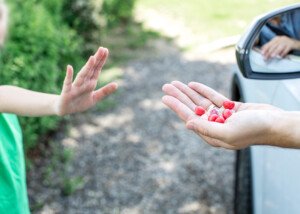
Here are very clever projects that will help kids understand what a stranger really is & how to sense danger and have more awareness for safety.
Perhaps you’ve warned your children, “Don’t talk to strangers!” till you were blue in the face, but have you ever checked to see if your child actually knows what a stranger is?
Many parents focus only on convincing their kids to “avoid” or “stay away from” strangers without helping their kids understand just what “stranger” means.
To the parent, the concept of what a stranger is may seem incredibly simple. But the younger a child, the more abstract this concept is. Ask your child what they think a “stranger” is.
They might reply, “Someone I don’t know.” But many others will reply in a way that shows they don’t understand.
I once asked a child to tell me what a stranger is. She replied, “You don’t talk to strangers.”
I then said, “That’s what you’re not supposed to do. But can you tell me what a stranger IS.” She really couldn’t.
Knowing what you shouldn’t do is worthless if you don’t know to whom this rule should apply.
“We need to help children understand what we mean when we use the word strangers, and help them, through reinforcement and repetition, understand the nuances in regard to the topic of strangers,” explains child/adolescent psychiatrist Dr. Marilyn Benoit, Chief Clinical Officer and SVP of Clinical & Professional Affairs of Devereux. Devereux is one of the largest not-for-profit behavioral healthcare organizations in the U.S., helping children and adults with emotional, developmental, educational and cognitive disabilities since 1912.
Ask child to write down 10 traits of a stranger (five if the child is very young). What they write will be very telling of their concept of strangerhood.
For example, if they write down “He has a weapon,” or, “He has tattoos,” you have some talking to do.
Ask questions like, “Can a stranger be handsome?” “Can a stranger be well-dressed”? Then discuss.
The most compelling project, though, is having your child DRAW what they think a stranger looks like. Supply crayons in many colors.
Many years ago I became aware of a study in which young kids were asked to draw a stranger. I was not able to locate this study online, but the results were disturbing.
Without having been given any prompts, the kids drew pictures of ugly faces, some looking almost monster-like. Lack of drawing skills had nothing to do with it.
They used mostly black, brown and grey crayons. None of the facial expressions looked friendly; some were mean. Hair was wild in some.
This study showed that children equated strangers with ugliness, nasty expressions and dark, dreary colors.
When you have your child make a drawing, do not give any suggestions. Just say, “Draw a stranger.”
Have them do this BEFORE you ask them to write down what they think a stranger looks or acts like.
Then, without discussing the drawings, have them do the writing drills. THEN discuss everything.
Next Project
Dr. Benoit strongly recommends role playing. “Repetition is key. It would be nice to see this performed in classrooms as well. The group setting really facilitates the learning.”
Dr. Benoit urges parents to work together, “to participate in discussions and role playing activities with children. With groups of parents and children, there may be great opportunities for parents to use settings and hypotheticals to contextualize for children and explain differences between sociability and trust.”
Finally, make sure your child knows the difference between approaching a stranger if they need help, and a stranger approaching them asking for help or offering goodies or a ride. Big difference!
 Dr. Benoit is past president of the American Academy of Child and Adolescent Psychiatry and has provided Congressional testimony on issues including child abuse, teen pregnancy and youth suicide.
Dr. Benoit is past president of the American Academy of Child and Adolescent Psychiatry and has provided Congressional testimony on issues including child abuse, teen pregnancy and youth suicide.
 Lorra Garrick has been covering medical, fitness and cybersecurity topics for many years, having written thousands of articles for print magazines and websites, including as a ghostwriter. She’s also a former ACE-certified personal trainer.
Lorra Garrick has been covering medical, fitness and cybersecurity topics for many years, having written thousands of articles for print magazines and websites, including as a ghostwriter. She’s also a former ACE-certified personal trainer.
.









































